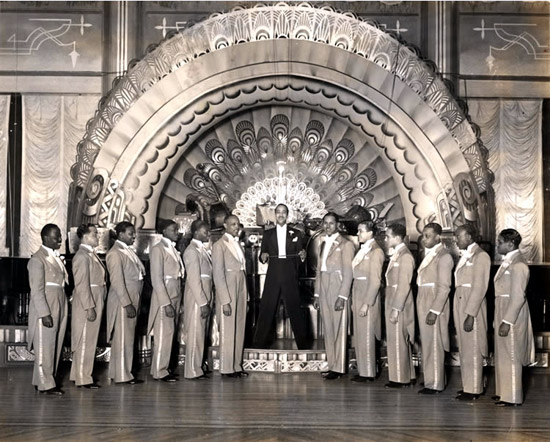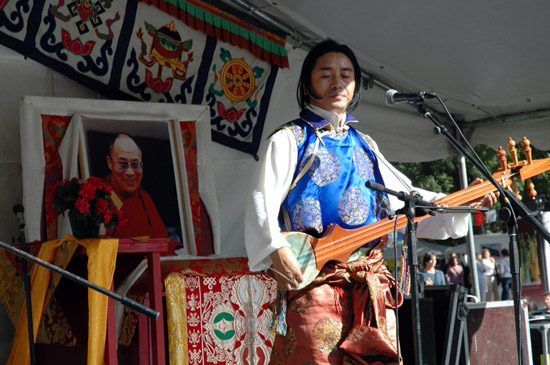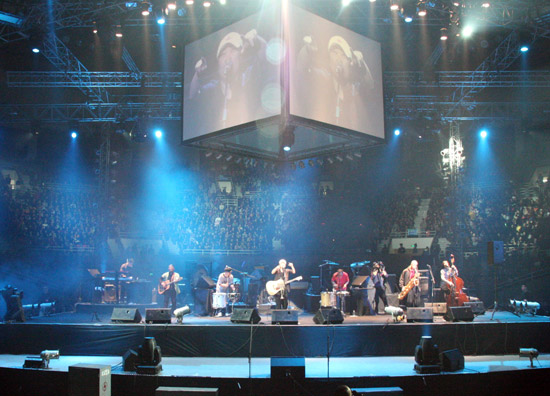Music: Modern Forms
Pop Music
In the 1920s, the appeal of Western jazz music led the musicians Li Jinhui and Buck Clayton to develop shidaiqu, an indigenous folk-jazz fusion form that featured Western jazz instruments and had Mandarin lyrics. Shidaiqu and the later Mandopop (pop music in Mandarin) and Cantopop (pop music in Cantonese) reverberated in the Shanghai nightclubs in the 1940s, featured in Chinese film soundtracks, and were dispensed to a wider audience by way of gramophone records. The mostly lighthearted lyrics and lively tunes made these new music genres popular even among non-Mandarin and non-Cantonese speakers, and the seven leading pop singers—Bai Guang, Bai Hong, Gong Qiuxia, Li Xinglan, Wu Yingyin, Yao Lee, and Zhou Xuan—known collectively as the Seven Great Singing Stars, became household names. The Japanese invasion and occupation of Shanghai put an end to the burgeoning music scene.
Another popular music form from the 1920s, gyoyue, was basically a continuation of traditional music is a more modernized format. Revolutionary and patriotic songs came under gyoyue, and received wide patronage from the Communists, often to the exclusion of other music forms. Guoyue was often the only music broadcast on radio and TV and taught in the conservatories, and this may, to an extent, explain its extraordinary popularity, as government censorship prevented access to most other musical choices.
Deng Xiaoping’s reform policies revived the pop music industry, and there has now been an upsurge in music shows and contests. TV programs like Super Girl and Super Boy give upcoming singers a platform. Some well-known singers include Teresa Teng, Faye Wong, and Jacky Cheung, and popular bands include Top Combine, HIT-5, UP Girls, and RTA.
Tibetan Pop
Tibetan pop music is a blend of traditional melodies and Chinese, Indian, and Western pop music. Sanitized versions of music from the Tibetan diaspora have also influenced it. Due to political restrictions on nationalist and religious expressions, Tibetan pop musicians generally stick to safe secular and moralistic themes. Alan Dawa Dolma, Jampa Tsering, Sherten, Kelsang Metok, Purba Rgyal, Yatong, and Dadon are some of the notable singers. Nangma karaoke music bars are popular in Lhasa, but their focus on classical songs with a distinctly Tibetan identity is not exactly on par with the communist ideology, and they face an uncertain future.
Rock Music
Like Chinese pop music, rock music is similarly categorized into Mandorock and Cantorock. A fusion of Western rock music elements with those of traditional music, Chinese rock music got its real start in the 1980s with the fast-paced, individualistic Northwest Wind music style of Cui Jian, a musician renowned for his revolutionary youth anthem “Nothing to My Name.” The tameness of Cantopop was set aside for music of more self-assertive originality, and, since governmental support for the Westernized genre was not too forthcoming, a vibrant underground music scene evolved.
After the Tiananmen Square crackdown, many musicians understandably hesitate to express political views in their songs. Punk, heavy metal, rap, and hip-hop became popular from 2000 onward. Censorship continues, but, as long as one toes the line, it is possible to appear on radio and TV music programs, and to participate in pop, rock, jazz, and hip-hop music festivals that take place in Beijing every year and in which both Chinese and foreign musicians participate. Some of the leading names include the rock musicians Wang Feng, Show Luo, and Jolin, bands like Brain Failure, Joyside, and Reflector, and rapper groups like Big Zoo and Yin T’sang.
Article written for World Trade Press by Sonal Panse.
Copyright © 1993—2025 World Trade Press. All rights reserved.

 China
China 

